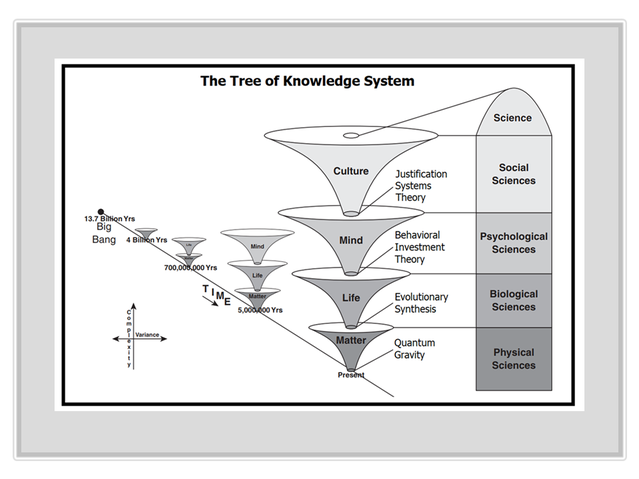Wisdom
What Is the Unified Theory of Knowledge?
A new theory of knowledge that orients us toward wisdom in the 21st century.
Posted September 4, 2020
In 1998, the famed sociobiologist and naturalist Edward O. Wilson published Consilience: The Unity of Knowledge. As suggested by the subtitle, "consilience" refers to a unified picture of human knowledge. For Wilson, that meant a vision that allows for a coherent, comprehensive view of our place in the cosmos that stretches across time and complexity from physics to sociology in the sciences and does so in a way that is commensurate with the creative expressions of our potentials afforded by the arts and humanities.
The Unified Theory of Knowledge (UTOK) offers a vision of consilience much as was hoped for by Wilson. However, it succeeds where Wilson failed because it solves the problem of psychology and affords a much more effective alignment with the humanities. It also is commensurate with many of the deep insights of the ancient wisdom traditions, and it embraces a nondual naturalistic-spiritual worldview.
The UTOK consists of eight key ideas that both solve the problem of psychology and set the stage for a unified approach to psychotherapy. It is a metamodern vision that seeks to include and transcend the Culture-Person sensibilities that have evolved over the eons. Specifically, it embraces the indigenous-folk sensibilities of relational-natural embeddedness, premodern formal mythic narratives that afford meaning-making on the scale of civilizations, modernist liberal democratic ideals that emphasize the power of science and reason, and postmodern deconstructive critiques that seek justice and caution against singular grand narratives. Both embracing and transcending these sensibilities, the UTOK is a constructive, integrative pluralistic metamodern vision of consilience that bridges the sciences and humanities and brings them together in a mutually inspiring dialectical dance that orients toward wisdom in the 21st century.
The UTOK is represented by a sincerely ironic metamodern work of art called “The Garden of UTUA.” As shown in this educational presentation of “The Tour of the Garden,” the message is for humans locally and humanity globally to cultivate their "Gardens" across the ecological scales, which range from individuals to dyads to families to groups to states to nations to transnational and finally global systems, such that all of God's creatures are woven into the fabric of being and becoming toward the ultimate good.

The metaphor of the Garden and the Tree speaks to how the system is grounded in the mythic traditions of the West, whereas the eight key branches that end with an emphasis on mindful living are suggestive of a bend toward the Eastern wisdom traditions and the importance of philosophy with practical implications for a life lived well.
As represented by the WIC-W Bee, the core message of the Garden is about cultivating principles that are organized by four keywords as follows: 1) wisdom (i.e., values-based knowledge and practices); 2) interests (i.e., needs, resources, and desires of self, others, and the world in general); 3) character (i.e., the virtuous development and adaptation of personality); and 4) well-being (i.e., individual and collective happiness with the worthiness to be happy). The ultimate justification of the Garden is summarized by the phrase: Be that which enhances dignity and well-being with integrity.

With the acknowledgement that it can be initially experienced as a potentially confusing twist, the first branch of the UTOK Tree in the Garden is the Tree of Knowledge System. The ToK System offers a 21st-century view of “Modern Empirical Natural Science” that resolves the Enlightenment's longstanding struggles with mind-matter metaphysics and shows how cosmic evolution has unfolded in four major phases of Matter, Life, Mind, and Culture.

The ToK System carries the crucial insight that each complex adaptive plane of existence following Matter is deeply associated with the emergence of a novel information processing and communication system. Thus, DNA/RNA/protein processing and cell-cell communication structure the Life dimension, and the neuro-information processing and animal-animal communication structures the Mind dimension, and the human symbolic-syntactical information processing and person-person communication structures the Culture dimension.
The patterned analysis shows why the 21st century is shaping up to include a massive phase shift in complex adaptive patterning. That is, a new singularity is on the horizon, and the UTOK can frame this emergence. The 20th century saw the emergence of artificial intelligence and computers, worldwide internet, and massive increases in electronic communication and memory storage. Now, with an internet of things and emerging neural linkages, we are in the midst of an explosion that is akin to the Cambrian explosion of animals 550 million years ago or the human mind’s big bang that resulted in the Culture-Person plane of existence taking off approximately 50,000 years ago.
As we begin the process of our deep informational interface and transformation in the domain of the Digital, everything is in flux and accelerating, which is all the more reason that we need to merge MENS Knowledge with a Wisdom Orientation going forward, as the possibilities and pitfalls that humanity faces are enormous. Indeed, according to the vision afforded by the UTOK, as we travel through the 5th Joint Point, the very landscapes of heaven and hell are before us. Let us hope we choose wisely in the decades to come.




